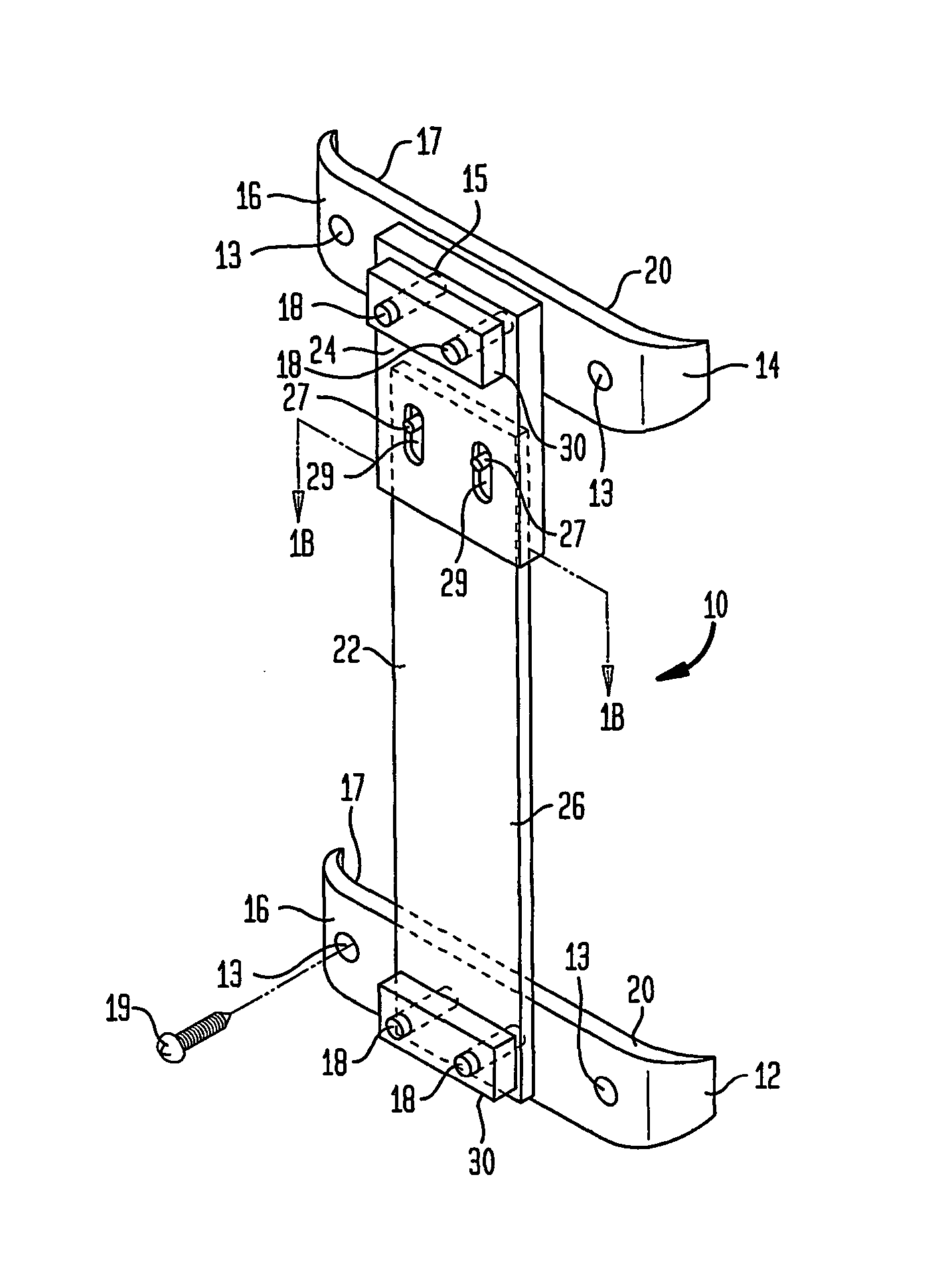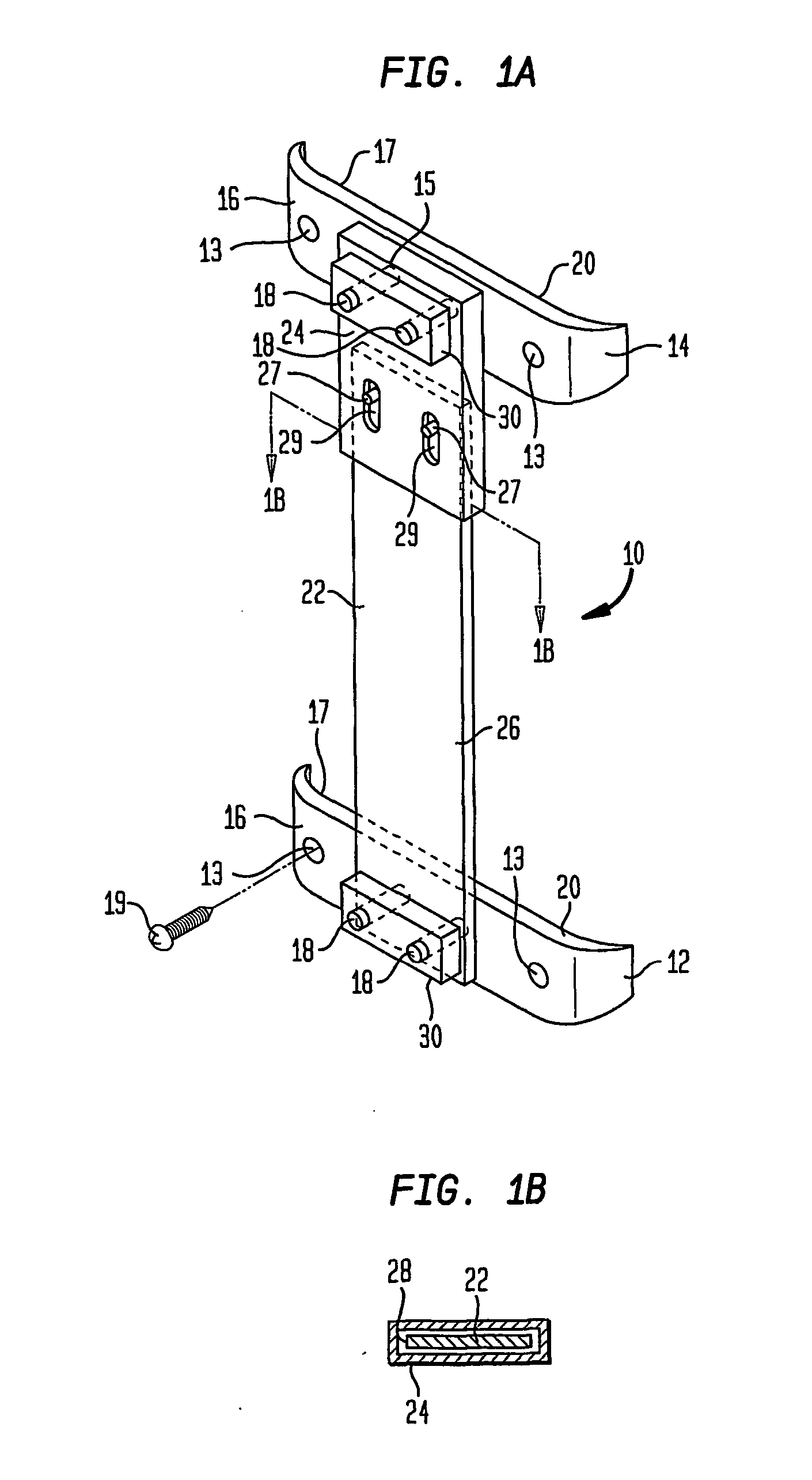[0014] In a further embodiment of the invention, a generally rectangular adjustable sleeve slidably connects the uppermost template and the lowermost template by means of the aforementioned posts and / or apertures through, the templates. It is an
advantage of the invention that perfect placement of the adjustable sleeve is achieved because the posts extend generally perpendicular with respect to the midportion of the anterior
vertebral body. The adjustable sleeve has a bottom sleeve portion that perpendicularly couples at a first end to the middle region of the lowermost template. A second end of the bottom sleeve portion extends upward toward the uppermost template. With respect to the distance between the anterior and posterior surfaces, the bottom sleeve portion will have a thickness at the first end that differs from that of its second end. In some embodiments of the invention, the thickness at the first end is about 1 mm and will increase to about 2 mm in the middle region and at second end of the bottom sleeve portion. The reason for the
varying thickness is so that several adjustable sleeves can be stacked onto the posts of the lowermost template without any large protrusions in the lowermost template area. The thickness of the lowermost template is not limited to 1 mm and 2 mm since sleeves of various thicknesses will be needed depending on the needs of a particular surgical procedure.
[0015] In a further embodiment, the adjustable sleeve has a top sleeve portion with a first end that couples to post holes in the middle region of the uppermost template. The top sleeve portion also extends downward toward the bottom sleeve portion and terminates at a second end. With regard to thickness (i.e., the distance between the anterior and posterior surfaces), the top sleeve portion will have a different thickness at the first end than at the second end of the top sleeve portion. Illustratively, the thickness at the first end can be about 1 mm and will increase to about 2 mm as for the middle and second end of the top sleeve portion. The reason for the
varying thickness is so that several adjustable sleeves can be stacked onto the posts of the uppermost template without any large protrusions in the uppermost template area. The thickness of the uppermost template is not limited to 1 mm and 2 mm since sleeves of various thicknesses will be needed depending on the needs of a particular surgical procedure. The second end of the top sleeve portion also has an opening to a hollow channel that extends upward toward the first end of the top sleeve portion. The second end of the bottom sleeve portion enters the bottom end of the top sleeve portion and is slidably disposed through the hollow channel.
[0016] The hollow channel affords mobility to the top third of the adjustable sleeve and allows the height of the mobile sleeve to adjust for post-operative
subsidence of the vertebrae. The movement of the adjustable sleeve during
subsidence enables the resulting load to be shared equally by all of the components of the mobile sleeve. Such distribution of the load increases the integrity of the mobile sleeve by preventing the damage to the templates, adjustable sleeve, or the vertebrae that may occur when the load is not equally distributed.
[0017] In order to control sliding movement between the top and lowermost templates, a
tongue and groove mechanism can, in certain embodiments, be incorporated along the
anterior surface of the adjustable sleeve. One or more tongues protrude from the
anterior surface of the bottom sleeve portion that is disposed through the hollow channel, extending orthogonally outward from the
anterior surface. One or more grooves are located on the anterior surface of the top sleeve portion and are arranged to extend completely through the anterior side of the top sleeve portion, whereby the tongues will extend into and slide freely within the grooves. In the practice of this embodiment, the grooves are of sufficient length to allow a top sleeve portion and a bottom sleeve portion to slide relative to each other and thereby accommodate subsidence of the vertebrae. However, the grooves will not be so long as to permit the bottom sleeve portion to become separated from the top sleeve portion.
[0018] The lowermost two thirds portion of the adjustable sleeve (i.e., the lower portion of the bottom sleeve portion) is formed of a
solid material that can be bent with a plate bender so that the adjustable sleeve will correspond substantially to the curvature of the
vertebral column. Although the adjustable sleeve is described herein as having a top third portion that can be adjusted for length and a bottom two thirds that are
solid, different ratios are achievable depending upon the region to which the mobile sleeve is to be attached, or the particular needs of a patient.
[0019] In a further embodiment, a
locking plate holds the adjustable sleeve and template together to allow the distribution of stress to all the parts of the mobile sleeve. Controlling the distribution of stress contributes to advantageous distribution of the load by ensuring that no one particular portion of the mobile sleeve is burdened excessively by the stress that is caused by the subsidence of the vertebrae. The
locking plate in this embodiment has two or more post holes that are aligned and placed onto the two or more posts of the bottom or uppermost templates. In order to hold the
locking plate in place, the post holes of the locking plate are configured to be secured onto the posts as the locking plate moves into place. In other embodiments, the posts of the uppermost template and the lowermost template are threaded so that a
fastener, such as a nut, can be used to lock the locking plate in place.
 Login to View More
Login to View More  Login to View More
Login to View More 


